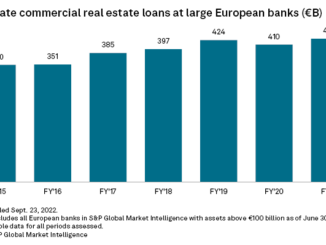
The conforming loan limit for mortgages backed by Fannie Mae and Freddie Mac will pass the $1 million mark for the first time in 2023, reigniting a debate about the government’s role in the mortgage market and its persistent affordability challenges.
Meanwhile, desperate for volume in a high-rate environment that’s pushed borrowers to the sidelines, some of the top U.S. nonbank lenders are wasting no time. They’ll adopt the 2023 FHFA rates effective Tuesday, even though the official loan limits won’t take effect until January 1.
The Federal Housing Finance Agency (FHFA), the regulator of Fannie Mae and Freddie Mac, announced that the baseline conforming loan limit in 2023 will increase by 12.21%, or $79,000, compared to 2022, to $726,200.
The new ceiling for one-unit properties in designated high-cost areas will reach $1,089,300 — or 150% of $726,200. That’s the same limit for Alaska, Hawaii, Guam, and the U.S. Virgin Islands, based on special statutory provisions.
As early as September, months ahead of the FHFA announcement, a group of mortgage lenders raised their ceilings to $715,000 (baseline) and $970,800 (high-cost areas), lower compared to the loan limits announced.
However, Rocket Mortgage said it will offer the new ceiling within 24 hours. Homepoint will begin lending at the FHFA 2023 loan limits for conventional products starting Wednesday, November 30. Pennymac said the new FHFA conforming loan limits for its borrowers increased immediately following the announcement. United Wholesale Mortgage will honor the new limits starting November 30 for conventional and VA loans.
That the conforming loan limit will eclipse $1 million in designated counties next year raises alarm for some housing groups. The Housing Policy Council, which represents large mortgage lenders and servicers, said the new loan limits exacerbate the current affordability crisis.
“Taxpayer backing of ever-increasing loan sizes provides a subsidy that results in slightly lower mortgage rates which, in turn, encourages people to buy more expensive homes,” the trade group said in a statement.
They added, “Ultimately, such backing feeds the runup in house prices, exacerbating the affordability challenges we face in today’s supply-constrained marketplace.”
The mortgage market relies upon government and taxpayer backing, meaning it shifted away from private companies to assess and manage mortgage credit risk, the group argued.
“The housing finance system is more resilient when private capital shares the risk of loss,” HPC argued. “With appropriate reforms and transition, there is no reason to believe that private capital cannot serve a greater role than it does today.”
Raise the (conforming loan) roof
The Housing and Economic Recovery Act in 2008 established a formula based on home prices for increasing conforming loan limits for Fannie Mae and Freddie Mac.
It mandated that the baseline could only rise after home prices returned to pre-recession levels. That condition was finally met in 2016 when the FHFA increased conforming limits for the first time in a decade.
House prices increased 12.21% on average between the third quarters of 2021 and 2022, thus increasing the baseline conforming loan limit in 2023 by the same percentage, the FHFA said in a statement Tuesday.
The ceiling doesn’t drop even if home prices fall, but it does rise if home prices are up year over year. And, over the last couple of years, home appreciation was significantly higher in the U.S. market due to lower rates and supply constraints.
“The idea is that the conforming loan limit increases over time, with the increase in average home prices. So, it’s not as if Fannie and Freddie’s footprint is going to grow. If this is done correctly, their footprint should remain roughly the same,” Mike Fratantoni, Mortgage Bankers Association’s (MBA) senior vice president and chief economist, said.
Data from the Urban Institute shows that Fannie Mae and Freddie Mac were responsible for 48.2% of the first lien origination volume in the second quarter, compared to around 60% in 2020 and 2021.
According to the nonprofit group, the decline reflects a substantial slowdown in refinancing business. During 2009 and 2013, the GSEs’ share was about 60%, but fell to about 40% between 2014 to 2019, the data shows.
According to Fratantoni, the conforming loan limit rule is functioning as intended. “I think what was unexpected was having a couple of years of nearly 20% home price growth, and that’s impacting affordability,” he said.
Due to the recent spike in mortgage rates, among other reasons, the MBA does not expect the same level of home appreciation in the next couple of years. The trade group expects home prices to remain flat in 2023 and 2024.
When asked if the Housing and Economic Recovery Act in 2008 needs to be updated, Fratantoni said that MBA has been advocating for GSE reform.
Regarding the impact of the GSEs footprint on the market, Fratantoni noted that rates on jumbo loans are much lower than conforming loans.
“There’s a lot of banks and credit unions and other depositories that are very interested in holding jumbo loans. And this (the new loan limit) isn’t going to change that. A loan eligible for the GSEs does not guarantee it’s going to end up with one of the GSEs.”
The market has been particularly tough on non-agency jumbo lenders of late. Originations of non-agency jumbo mortgages fell 34.8% in the third quarter from the prior quarter to $88 billion, according to data from Inside Mortgage Finance. That was a greater decline than the overall market saw. By contrast, first-lien lending overall fell 22.3% to $505 billion in the third quarter.
Mortgage rates were 6.65% for 30-year fixed conventional loans on Tuesday afternoon, compared to 5.95% for the 30-year fixed jumbo loans, according to Mortgage News Daily.



